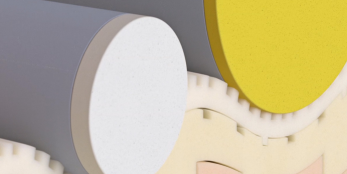Before working with this product, you must read and become familiar with the available information on its risks, proper use, and handling. Information is available in several forms, e.g., in particular in the currently valid safety data sheets and product labels. For further information contact your Covestro representative.
Product description
Bayflex MP-10,000 IMR is a solid elastomer which has a flexural modulus of approximately 10,000 psi (69 MPa) at room temperature.*
Applications
Bayflex MP-10,000 IMR is a solid elastomer which has a flexural modulus of approximately 10,000 psi (69 MPa) at room temperature.* It is processed on reaction injection molding (RIM) equipment and is used for rollers, gaskets, and encapsulated windows. This system combines rapid demold times, excellent integrity at demold, improved release characteristics, and outstanding physical properties. This system also offers the advantage of an internal mold release (IMR). It is formulated to provide excellent releasability during production of RIM encapsulated windows while still maintaining strong adhesion to primed glass. Compatibility between MP-10,000 IMR and current industrial in-mold coatings is equivalent to standard Bayflex MP systems. The incorporation of internal mold release technology into RIM modular window production reduces the frequency of external mold release application. This can increase productivity by decreasing cycle time and reducing the frequency of mold cleaning. As with any product, use of the Bayflex MP-10,000 IMR system in a given application must be tested (including field testing, etc.) in advance by the user to determine suitability.
Storage
Bayflex MP-10,000 IMR is a formulated RIM system supplied as two liquid components. Component A is a diphenylmethane diisocyanate (MDI) prepolymer, and Component B is a polyether polyol. Note: Component B should be agitated thoroughly prior to transfer of contents from the drum to the day tank.Component A (MDI prepolymer) must be stored in tightly closed containers and protected from contamination with moisture and other foreign substances, which can adversely affect processing. It will react slowly with water to form ureas and carbon dioxide gas, which may cause sealed containers to expand and rupture. The headspace of partially filled containers should be blanketed with dry nitrogen. Storage temperatures should be maintained between 24° and 30°C (75° and 86°F). Under these conditions, Component A will remain clear for up to six months. Within this range, lower storage temperatures will maximize the storage life of the product. Component A must not be allowed to freeze. Exposure to temperatures less than 15°C (59°F), even for short periods of time, can result in the formation of solid material. During the winter months, appropriate precautions must be taken during shipment and storage. Prolonged storage of solid or partially solid Component A may result in the formation of MDI dimer in amounts which exceed its solubility in the prepolymer at normal storage temperatures. This can make the product unusable.If solids should form because of exposure of Component A to lower temperatures, it may be possible to reliquify the product by heating. Use a well-ventilated oven for the minimum time necessary to render it clear. The temperature of the product should not exceed 60°C (140°F). Agitation or drum rollers are recommended to avoid excessive local heating, which will degrade the prepolymer. Significant amounts of MDI dimer may form during the heating process. As a result, the remelted prepolymer may be cloudy, and the processing behavior and properties of the final product may be affected.Component B (polyol) is normally shipped in 55-gallon lined steel drums. The material is hygroscopic and should be kept in tightly closed containers or blanketed with a dry atmosphere to prevent contamination with atmospheric moisture and foreign materials, which can adversely affect processing. Storage temperatures should be in the range of 15°and 43°C (59°and 110°F).
Processing
* These items are provided as general information only. They are approximate values and are not part of the product specifications.** Flammability results are based on small-scale laboratory tests for purposes of the hazards presented by this or any other material under actual fire conditions.a Postcured at 121°C for one hour.
Health and Safety Information
Disclaimer
General
The manner in which you use our products, technical assistance and information (whether verbal, written or by way of production evaluations), including any suggested formulations and recommendations, are beyond our control. Therefore, it is imperative that you test our products to determine suitability for your processing and intended uses. Your analysis must at least include testing to determine suitability from a technical, health, safety, and environmental and regulatory standpoint. Such testing has not necessarily been done by Covestro, and Covestro has not obtained any approvals or licenses for a particular use or application of the product.
Unless we otherwise agree in writing, all products are sold strictly pursuant to the terms of our standard conditions of sale which are available upon request.
All information and including technical assistance is given without warranty or guarantee and is subject to change without notice. It is expressly understood and agreed by you that you assume and hereby expressly release indemnify us and hold us harmless from all liability, in tort, contract or otherwise, incurred in connection with the use of our products, technical assistance, and information. Any statement or recommendation not contained herein is unauthorized and shall not bind us. Nothing herein shall be construed as a recommendation to use any product in conflict with any claim of any patent relative to any material or its use. No license is implied or in fact granted under the claims of any patent.
Non Medical and non Food Contact
This product is not designated for the manufacture of a medical device or of intermediate products for medical devices (1). This product is also not designated for other specifically regulated applications (e.g. including cosmetics, plant protection, fertilisers, plant strengtheners, food processing, food contact and others). If the intended use of the product is for the manufacture of a medical device or of intermediate products for medical devices or for other specifically regulated applications Covestro must be contacted in advance to provide its agreement to sell such product for such purpose. Nonetheless, any determination as to whether a product is appropriate for use in a medical device or intermediate products for medical devices, for Food Contact products or cosmetic applications must be made solely by the purchaser of the product without relying upon any representations by Covestro.
1) Please see the Guidance on Use of Covestro Products in a Medical Application document.
Sample
Any samples provided by Covestro are for testing purposes only and not for commercial use.
Typical value
These values are typical values only. Unless explicitly agreed in written form, they do not constitute a binding material specification or warranted values
Contact Information
Please use our contact form or contact us directly by sending an e-mail to technical-datasheets@cx.covestro.com .








